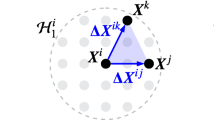Abstract
Peridynamics (PD), a recently developed theory of solid mechanics, which employs a non-local model of force interaction and makes use of integral formulation rather than the spatial partial differential equations used in the classical continuum mechanics theory, has shown effectiveness and promise in solving discontinuous problems at both macro and micro scales. In this paper, the peridynamics theory is used to analyze damage and progressive failure of concrete structures. A non-local peridynamic model for a rectangular concrete plate is developed, and a central pairwise force function is introduced to describe the interior interactions between particles within some definite distance. Damage initiation, evolution and crack propagation in the concrete model subject to in-plane uni-axial tension, in-plane uni-axial compression and out-of-plane impact load are investigated respectively. The numerical results show that discontinuities appear and grow spontaneously as part of the solution to the peridynamic equations of motion, and no special failure criteria or re-meshing techniques are required, which proves the potential of peridynamic modeling as a promising technique for analyzing the progressive failure of concrete materials and structures.
Similar content being viewed by others
References
Ren Q W, Dong Y W, Yu T T. Numerical modeling of concrete hydraulic fracturing with extended finite element method. Sci China Ser E-Tech Sci, 2009, 52(3): 559–565
Liu J, Zhao C B, Yun B. Numerical study on explosion-induced fractures of reinforced concrete structure by beam-particle model. Sci China Ser E-Tech Sci, 2011, 54(2): 412–419
Silling S A. Reformulation of elasticity theory for discontinuities and long-range forces. J Mech Phys Solids, 2000, 48(1): 175–209
Silling S A. Dynamic fracture modeling with a meshfree peridynamic code. In: Second MIT Conference on Computational Fluid and Solid Mechanics, MIT, Massachusetts, 2003
Silling S A, Askari E. A meshfree method based on the peridynamic model of solid mechanics. Comput Struct, 2005, 83(17): 1526–1535
Weckner O, Abeyaratne R. The effect of long-range forces on the dynamics of a bar. J Mech Phys Solids, 2005, 53(3): 705–728
Weckner O, Emmrich E. Numerical simulation of the dynamics of a non-local inhomogeneous, infinite bar. J Comput Appl Mech, 2005, 6(2): 311–319
Askari E, Bobaru F, Lehoucq R.B, et al. Peridynamics for multiscale materials modeling. J Phys Con Ser 125, 2008–012078, doi: 10.1088/1742-6596/125/1/012078
Lee B T, Han B D, Kim H D. Comparison of fracture characteristic of silicon nitride ceramics with and without second crystalline phase. Mater Lett, 2003, 58(1): 74–79
Grah M, Alzebdeh K, Sheng P, et al. Brittle intergranular failure in 2D microstructures: Experiments and computer simulations. Acta Materialia, 1996, 44(10): 4003–4018
Maiti S, Rangaswamy K, Geubelle P. Mesoscale analysis of dynamic fragmentation of ceramics under tension. Acta Mater, 2005, 53(3): 823–834
Kilic B, Madenci E. Prediction of crack paths in a quenched glass plate by using peridynamic theory. Int J Fracture, 2009, 156(2): 165–177
Askari E, Xu J, Silling S A. Peridynamic analysis of damage and failure in composites. In: 44th AIAA Aerospace Sciences Meeting and Exhibition, No. 2006-88, Reno, Nevada, 2006
Xu J, Askari A, Weckner O, et al. Damage and failure analysis of composite laminates under biaxial loads. In: 48th AIAA/ASME/AHS/ASC Structures, Structural Dynamics and Materials Conference, Honolulu, Hawaii, 2007
Silling S A, Lehoucq R B, Askari A. Peridynamic Modeling of the Dynamic Response of Heterogeneous Media. Sandia National Laboratory Report, SAND2009-0125C, 2009
Kilic B, Agwai A, Madenci E. Peridynamic theory for progressive damage prediction in center-cracked composite laminates. Compos Struct, 2009, 90(2): 141–151
Gerstle W, Sau N. Peridynamic modeling of concrete structures. In: Proceedings of the 5th International Conference on Fracture Mechanics of Concrete Structures, 2004. 949–956
Gerstle W, Sau N. Peridynamic modeling of plain and reinforced concrete structures. In: 18th Internatinal Conference on Structural Mechanics in Reactor Technology (SMiRT 18), Beijing, China, 2005
Gerstle W, Sau N, Silling S A. Peridynamic modeling of concrete structures. Nucl Eng Des, 2007, 237(12): 1250–1258
Kilic B. Peridynamic Theory for Progressive Failure Prediction in Homogeneous and Heterogeneous Materials. Ph.D. Thesis. The University of Arizona, Tucson, 2008
Kilic B, Madenci E. Structural stability and failure analysis using peridynamic theory. Int J Nonlin Mech, 2009, 44(8): 845–854
Silling S A. Peridynamic modeling of structural damage and failure. In: Proceedings of Salishan Conference on High Speed Computing, Gleneden Beach, Oregon, 2004
Silling S A. Peridynamic Modeling of the Failure of Heterogeneous Solids. Report on ARO Workshop on Analysis and Design of New Engineered Materials and Systems with Applications, Albuquerque, New Mexico, 2002
Zimmermann M. A Continuum Theory with Long-range Forces for Solids. Ph.D. Thesis. Massachusetts Institute of Technology, 2005
Weckner O, Brunk G, Epton M A, et al. Comparison between Local Elasticity and Non-local Peridynamics. Sandia National Laboratory Report, 1109J, 2009
Author information
Authors and Affiliations
Corresponding author
Rights and permissions
About this article
Cite this article
Huang, D., Zhang, Q. & Qiao, P. Damage and progressive failure of concrete structures using non-local peridynamic modeling. Sci. China Technol. Sci. 54, 591–596 (2011). https://doi.org/10.1007/s11431-011-4306-3
Received:
Accepted:
Published:
Issue Date:
DOI: https://doi.org/10.1007/s11431-011-4306-3




